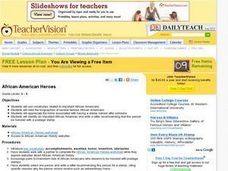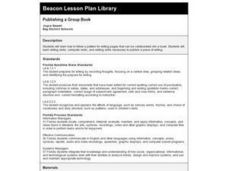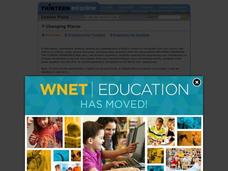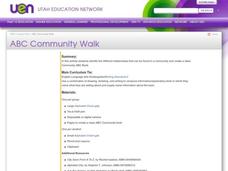Curated OER
Droopy Dog says....
Students study the /d/ sound by making the sound and determining where their tongue is when the make it. They repeat a tongue twister while emphasizing the /d/ sounds. Next, they identify the sound in words as the teacher uses a puppet...
Curated OER
Capitol Visitors Center
Students complete a post-trip discussion after visiting the capitol building in Austin. As a class, they review how soldiers received their allotment of land for participating in the Texas Revolution. Individually, they write a letter...
Curated OER
Citizenship Program
Students explore teamwork, decision-making, and ways to communicate. They discuss their favorite activities, places they would like to travel and set ground rules for their groups. After identifying their feelings toward the program,...
Curated OER
African-American Heroes
Students explore websites about famous African-Americans. They work in pairs to decide on an African American who should be honored with a stamp. They write a letter recommending this person for a stamp including appropriate reason why...
Curated OER
Computer Pictures
Students manipulate the mouse to draw a picture on a computer program such as Kid Works or ClarisWorks for Kids. Then, using the keyboard, the student type a word to label the picture and type his/her name.
Curated OER
Soaring High with Fluency
First graders identify reading with speed, ease, and skill making it easier for them to comprehend text. They complete an activity using pseudo words, but first identifying what they are and how they are pronounced. Finally, 1st...
Curated OER
Publishing a Group Book
Students examine various alphabet books. They write several sentences for their assigned letter of the alphabet, type them onto a word processing program, and create an illustration for a class alphabet book.
Curated OER
Changing Places
Young scholars examine the experiences of immigrants coming to America from China. They create cultural profiles for themselves and others. They identify the reasons why people immigrate to another country.
Curated OER
B is for Bowling Green
Third graders identify important places in Bowling Green and list facts about those places. They write complete, varied sentences using capitals and punctuation correctly and also use the Writing Process. As a final project, a...
Curated OER
Event in Time
Pupils describe and identify a variety of major consequences and sequences of several major historical events and developments in American History. They research a given topic and assess how its ideas, concepts and traditions have...
Curated OER
Reading Our Neighborhood
Students explore their environment and what they can read. In this instructional activity about signs, letters, and pictures in the neighborhood, students will observe what they see around them. Students walk around and take pictures of...
Curated OER
Polymers
Students explore online tutorial on polymers. In this chemistry lesson, they create two polymers in the lab and compare their properties. They write a sales letter about their new and improved polymer product.
Curated OER
Not Just an Average Class
Fourth graders work together to find the median, mode, and mean of their first and last names using a numerical code in this fun, interactive lesson. After a lecture/demo, 4th graders utilize a worksheet imbedded in this plan to gain...
Curated OER
Insects at Home
Fourth graders search their house and surrounding neighborhood for insects. They complete a chart that help students organize the name, physical description, location found, and any unique characteristics of the insect.
Curated OER
Reading Recall
Second graders review the vowe-consonant-e pattern in association with reading fluently. After identifying the changes made to a phoneme when the letter e is added at the end of the word, 2nd graders practice reading a phonetically...
Curated OER
A Happy Time
Second graders listen to stories about feelings, identify their own feelings at specific times in their lives, and express their feelings in words and through writing.
Curated OER
ABC Community Walk
Students listen to several stories about cities and different types of communities. They take a walk in their city to identify unique characteristics. They create an alphabet book using people or features of their own community to go...
Curated OER
Stamps
Third graders review how to mail a letter, how mail is moved from place to place and how the postal service operates. Using maps, they locate and identify the continents. They view photographs of various postage stamps from around the...
Curated OER
Cotton and Cabbage
High schoolers note how given traits could be achieved by selective breeding and by transgenesis. They identify different uses of GEO. Students recognize that the use of letters (Bt) before an organism's name means that the organism has...
Curated OER
The Long I Sound
Practice saying, sounding out, and identifying the long I sound with your class. They say each word on the sheet, unscramble the letters to spell the word correctly, and write the correct word on the line provided. The worksheet states...
Curated OER
Celebrate You
First graders locate place of birth on a map. They identify their birthdays and place a graphing square with their birthday written on it under the corresponding month. They compare birthdays on the graph. They read "P.B. Bear's Birthday...
Curated OER
Diphthongs
Second graders examine and identify the diphthongs /oi/ and /oy/. They discuss the two ways that this sound is spelled and read words containing this vowel combination, create a list of words with /oi/ and /oy/, and complete a worksheet.
Curated OER
Poetry: Ten Little Schoolchildren
Students analyze a sequential, story poem and put the stanzas in order. They identify repeated verses and answer questions about the poem. They identify examples of alliteration. Finally, they make their own poem in a given pattern.
Curated OER
What's Hatching in Kindergarten?
Students identify oviparous animals. They brainstorm a list of animals that lay eggs, read "Chickens Aren't The Only Ones" by Ruth Heller and then add to the list. Students complete a booklet that shows an egg and an oviparous animal.























